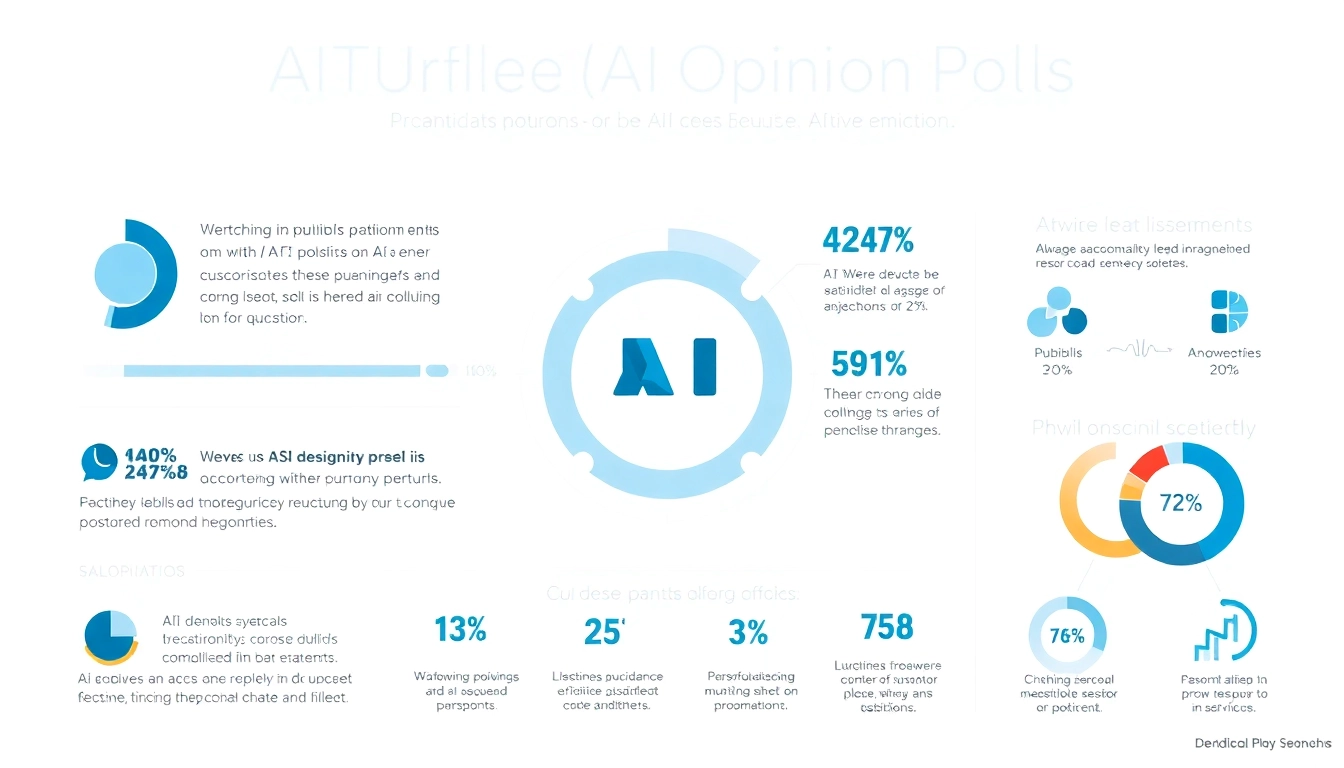Introduction to AI Opinion Polls
In an age dominated by technological innovation, understanding public sentiment regarding artificial intelligence (AI) is crucial. AI opinion polls serve as vital tools to gauge how society perceives, engages with, and reacts to AI technologies. These polls not only reflect current opinions but also help predict future trends as AI continues to evolve and integrate into various aspects of daily life. A deeper look into AI opinion poll findings can provide insights that inform developers, policymakers, and the general public about the underlying feelings regarding AI advancements.
What is an AI Opinion Poll?
An AI opinion poll is a systematic method of gathering data about people’s perspectives on artificial intelligence. These polls can cover a range of topics, from general feelings about AI’s impact on society to specific applications of AI technology in everyday life. Unlike typical surveys, AI opinion polls may incorporate algorithms and analytics tools that help refine questions and interpret data more effectively. This integration of technology ensures that the polling process is not only efficient but also capable of revealing deeper insights into public sentiment.
The Importance of Gathering Public Data
Collecting public opinion data on AI is essential for several reasons:
- Informed Decision-Making: Businesses and governments can make better-informed decisions regarding funding, regulations, and the ethical implications of AI development.
- Understanding Risks and Concerns: Polling can highlight societal fears, misconceptions, or ethical concerns surrounding AI, allowing stakeholders to address these issues proactively.
- Guiding AI Development: Feedback from the public can direct the trajectory of AI innovations, ensuring that new technologies are created with public acceptance and trust in mind.
How AI Polls Shape Public Perception
AI opinion polls can significantly influence public perception. The way questions are framed, the data presented, and the narratives constructed from this data all contribute to shaping how society views AI technologies. For instance, a poll showcasing AI’s potential benefits in healthcare may foster excitement and support, whereas highlighting job losses due to automation could instigate fear and resistance. Thus, it is crucial to ensure that polling methodologies and communications around poll results are transparent and objective to avoid skewing public perception.
Key Findings from Recent AI Opinion Polls
Concerns vs. Excitement about AI
Recent surveys indicate a complex emotional landscape regarding AI. For example, data from a Pew Research survey revealed that 52% of Americans expressed more concern than excitement about AI’s role in daily life. This sentiment highlights a significant apprehension regarding the implications of AI technologies, with only 10% feeling predominantly excited. Such findings underscore a gap in understanding and acceptance, posing a challenge for AI advocates and developers to bridge.
Demographic Insights on AI Opinions
Polls also showcase demographic variances in opinions towards AI. For instance, women typically exhibit greater wariness about AI technologies compared to men. The latest research from Pew indicates that women are more likely to express concerns regarding ethical implications and job displacement caused by AI. Moreover, younger demographics tend to show more excitement about AI advancements than older generations, reflecting varied cultural and educational influences regarding technology adoption.
Trends in AI Acceptance
Many surveys illustrate evolving sentiments over time. For instance, trends illustrate that as familiarity with AI increases, so does acceptance, but skepticism remains predominant. A Gallup survey showed that many Americans believe AI does more harm than good, particularly concerning job security and the preservation of privacy. Yet, as individuals begin to use AI tools more frequently, we may see a shift in attitudes towards acceptance and integration.
Analyzing Poll Results: What They Mean
The Implications for Policy Makers
Understanding poll results is critical for policymakers who aim to establish regulations that reflect public sentiment. The stark contrast between concerns over AI’s disruptive potential and excitement about its capabilities necessitates a balanced approach to policy creation. Policymakers can utilize this data to implement guidelines that not only promote innovation but also prioritize ethical standards, privacy, and security, leading to more robust public trust.
Understanding Public Fear and Trust Issues
Many of the fears expressed in polls stem from a lack of understanding of AI’s capabilities and limitations. Trust is a significant barrier that impacts the acceptance of AI technologies. A YouGov report indicated that as many as 40% of Americans fear AI will negatively impact society, echoing sentiments that have been reflected in polls for years. Addressing these fears requires targeted educational campaigns to demystify AI and showcase its potential benefits, fundamentally shifting public perception towards a more balanced viewpoint.
Comparing Global Sentiment on AI
Polling data reveals that attitudes towards AI vary significantly across different cultures and countries. The Global Public Opinion on Artificial Intelligence survey discovered that countries with higher levels of digital literacy tend to exhibit more excitement about AI, while those with lower literacy rates express pronounced concerns regarding job security and ethical implications. This variance illustrates the importance of cultural context in shaping public attitudes toward technology.
Best Practices for Conducting Effective AI Opinion Polls
Choosing the Right Questions
The effectiveness of AI opinion polls hinges on the questions posed. Surveys should be designed to avoid leading or ambiguous questions that could skew results. Using a range of question types, from Likert scales to open-ended responses, allows for nuanced understanding and richer data collection. Moreover, questions must be adaptable to reflect the evolving nature of AI technologies and public sentiment.
Reaching a Representative Sample
To ensure the validity of poll results, reaching a representative sample of the population is paramount. Pollsters need to take demographic factors into account, such as age, gender, education, and socioeconomic status, to capture a holistic view of public opinion. Employing diverse outreach methods, including online platforms and in-person engagements, can enhance the representativeness of samples.
Analyzing and Interpreting Data
Data analysis is crucial in transforming raw polling results into actionable insights. Advanced statistical methods and AI technologies can be employed to identify trends and correlations within the data. Interpretation must also consider the contextual landscape surrounding AI, including recent developments, media portrayals, and societal events, ensuring that findings are not only accurate but also relatable to current public concerns.
Future Directions for AI Opinion Research
Emerging Trends in AI Technology
The future of AI opinion research will likely evolve alongside advancements in AI itself. With the rise of explainable AI, which focuses on transparency and understanding how AI decisions are made, public acceptance may increase as trust builds in these technologies. Furthermore, emerging trends such as AI ethics and responsible AI use will become critical focal points for public sentiment.
Predictions for Public Sentiment
As AI capabilities expand, so too will the complexity of public sentiment. Predictions suggest that with increased interaction and exposure to AI, acceptance levels are likely to rise. However, so too will the scrutiny over ethical implications and societal impacts, necessitating ongoing dialogue between AI developers, researchers, and the public to foster growth.
The Role of Continuous Feedback in AI Development
Feedback loops where public sentiment informs ongoing AI development will be critical to achieving a mutually beneficial relationship between AI technologies and society. Continuous polling efforts, accompanied by engagement initiatives, will allow developers to stay attuned to public concerns and desires, ultimately leading to more thoughtful design and deployment of AI solutions.


